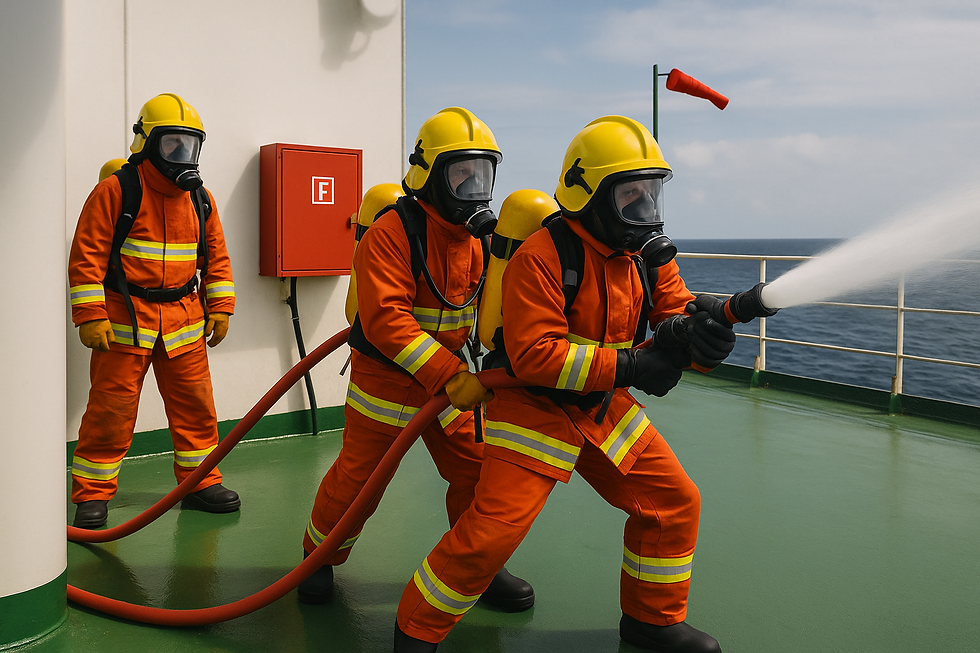Fire Drill on Board Ship
- Admin

- Sep 7
- 3 min read
Updated: Sep 8

🚒 Fire Drill on Board Ship – Step-by-Step Procedure
Fire is one of the most dangerous emergencies at sea. A well-organized fire drill ensures the crew can respond quickly, follow their assigned duties, and coordinate with the bridge.
Below is a practical checklist based on SOLAS requirements, standard shipboard practice, and real seafarer experience.
🚨 Crew Duties During Fire on Board Ship – Essential Actions
When a fire breaks out on board, every crew member has assigned duties according to the Muster List. The success of firefighting depends on discipline, communication, and following the correct sequence.
🧭 General Crew Actions 'Fire Drill on Board Ship'
☑️ Muster at assigned station with immersion suit & lifejacket.
☑️ Bring portable radios if assigned.
☑️ Wait for instructions from Master/Bridge.
☑️ Remain calm, avoid panic, and report any missing persons.
☑️ Follow Muster List assignments (never improvise unless ordered).
🔌 Containment and Isolation Duties
☑️ Close fire dampers and ventilation flaps near the fire.
☑️ Stop fans (AC, engine room, galley extraction, cargo fans).
☑️ Shut watertight doors/fire doors to contain fire and smoke.
☑️ Cut off electrical power in affected compartment (switchboards or local panels).
☑️ Shut fuel oil quick-closing valves if the fire is near tanks, pumps, or purifiers.
☑️ Stop cargo operations (if fire during loading/discharging).
☑️ Close oil tank sounding pipes/vents where safe to do so.
🚿 Firefighting Team Duties
☑️ Don fireman’s outfit and SCBA (check pressure ≥ 90% of rated — usually 200 or 300 bar).
☑️ Test comms and report ready for entry to BA Control.
☑️ Prepare charged fire hoses and extinguishers.
☑️ Stand by until Master gives order to attack.
☑️ Apply boundary cooling from outside fire area.
☑️ Entry team proceeds with search and rescue if safe.
☑️ BA Control records time in/out and cylinder pressures.
🧑⚕️ Medical & Rescue Team
☑️ Stand by with first aid kit, stretcher, and oxygen resuscitator.
☑️ Prepare casualty evacuation route.
☑️ Treat injuries (burns, smoke inhalation, CPR if required).
☑️ Report casualty status to bridge.
☑️ Coordinate with bridge for MEDEVAC if serious.
⚓ Support Duties
☑️ Start fire pumps and confirm water pressure at hydrants.
☑️ Bring additional SCBA sets, extinguishers, and spare hoses.
☑️ Keep escape routes clear and marked.
☑️ Maintain BA Control log (time in/out, cylinder pressure).
☑️ Provide boundary cooling teams on decks/compartments adjacent.
☑️ Ensure emergency generator is ready in case of blackout.
📡 Bridge & Command Duties
☑️ Record all reports and times in logbook.
☑️ Maintain communication with fire teams.
☑️ Decide if CO₂ / fixed system release is required (engine room/cargo space).
☑️ Keep contact with engine room and port authorities if in port.
☑️ Order emergency signals if escalation (abandon ship, distress).
☑️ Maintain continuous watch on GMDSS equipment for external assistance.
☑️ Inform company/CSO, flag state, and class if fire escalates or causes damage.
✅ After Fire Extinguished
☑️ Double-check for hot spots and smoke pockets.
☑️ Ventilate area gradually and safely.
☑️ Restore systems step by step (ventilation, power, cargo ops).
☑️ Conduct investigation into cause of fire.
☑️ Preserve evidence (photos, crew statements) for insurance/legal purposes.
☑️ Debrief crew and log all actions.
⚠️ Important Reminder
These steps are general practice. Always follow your ship’s Muster List, SMS, SOLAS, and flag state rules. The actual sequence and duties depend on the fire location, ship type, and available equipment.
Comments